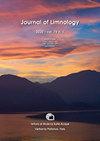高山淡水中寡毛类的分布:不仅仅是海拔的问题
IF 1.1
4区 环境科学与生态学
Q4 LIMNOLOGY
引用次数: 0
摘要
由于气候变化,高山淡水生物多样性面临灭绝的危险,一些物种在灭绝之前可能仍未被描述。这些物种尚未被列入法律保护的红色名单,例如高山栖息地的环节动物。在此背景下,我们研究了意大利阿尔卑斯山脉3个冰川集水区(Noce Bianco、Careser和Conca-Carè Alto;Trentino省)。本研究旨在描述不同取样方法(踢腿取样和漂移取样)采集的不同生境类型的节动物群落,并探讨物种丰富度和丰度与海拔的关系。从2000年到2005年,我们在418个样本中收集了4765个人。鉴定出多毛纲(Aeolosoma) 1属,少毛纲36种,分属4科:卷毛纲(enytraeidae) 28种,卷毛纲(Lumbriculidae) 4种,卷毛纲(Naididae) 3种,卷毛纲(Tubificinae)幼鱼3种,单叶纲(Haplotaxidae) 1种。意大利新发现5种:carpatica卷毛纲(Cernosvitoviella cf. crassoductus), brucei卷毛纲(Henlea glandulifera),卷毛纲(Mesenchytraeus sanguineus)。与预期的一样,在所有样地中均以Enchytraeidae科占优势,其中以Cernosvitoviella属和Cognettia属最丰富、最常见。回归分析和聚类分析以及广义线性混合模型的结果表明,不同生境间物种丰富度和丰度的差异主要受生境类型和海拔高度的影响。只有在Noce Bianco和Careser冰川补给的河流中存在明显的纵向物种更替,分类多样性(通过系列化分析测试)和丰度随距离冰川锋的增加和海拔的降低而增加。结果表明,该生境的物种和个体数量最少,以半水栖和陆生内生类群为主。研究发现,在收集寡毛藻方面,漂变取样比踢动取样更有效,特别是在冰川补给的溪流中,由于其流量高且变化很大,池塘网的使用通常受到阻碍。本研究提供了高寒淡水中寡毛动物区系的新数据,有助于建立不包括环节动物的高寒生物多样性预测模型。本文章由计算机程序翻译,如有差异,请以英文原文为准。
Oligochaete distribution in alpine freshwaters: not a mere question of altitude
Alpine freshwater biodiversity is at risk of extinction due to climate change and some species could remain undescribed before they go extinct. These species are not yet included in red lists of protection by law, such as annelids in alpine habitats. Within this context, we studied the annelid fauna in 20 sites located between 1223 and 2703 m asl, belonging to different habitat types (kryal, glacio-rhithral, non-glacial streams, springs, littoral lake zone), in three glaciated catchments of the Italian Alps (Noce Bianco, Careser and Conca-Carè Alto; Trentino Province). The aim of this study was to describe the annelid communities of the different habitat types collected with different sampling methods (kick sampling and drift) and investigate the relationships between species richness and abundance with altitude. Between the years 2000 and 2005, we collected 4,765 individuals in 418 samples. One genus of Polychaeta (Aeolosoma) and 36 species of Oligochaeta were identified, distributed in four families: Enchytraeidae (28), Lumbriculidae (4), Naididae (3 and Tubificinae juveniles) and Haplotaxidae (1). Five species were new to Italy: Cernosvitoviella carpatica, Cernosvitoviella cf. crassoductus, Henlea brucei, Henlea glandulifera and Mesenchytraeus sanguineus. As expected, Enchytraeidae prevailed in all sites with the genera Cernosvitoviella and Cognettia the most abundant and frequent. The regression and cluster analyses and the generalized linear mixed models we performed, highlighted that the differences in species richness and abundance among sites are explainable partly by altitude but mainly by habitat type. A clear longitudinal species turnover was evident only in the Noce Bianco and Careser glacier-fed streams, where taxonomic diversity (tested by Seriation analysis) and abundance increased with increasing distance from the glacier front and decreasing altitude. Also expected, the harsh kryal habitat was the poorest in species and individuals, with a dominance of semi-aquatic and terrestrial enchytraeid taxa. Drift was found to be more effective than kick sampling in collecting oligochaetes, especially in glacier-fed streams where the use of the pond net is generally hindered by their high and highly variable discharge. In conclusion, this study provides new data on oligochaete fauna in alpine freshwaters, useful to implement the prevision models for Alpine biodiversity up to date not including annelid fauna.
求助全文
通过发布文献求助,成功后即可免费获取论文全文。
去求助
来源期刊

Journal of Limnology
地学-湖沼学
CiteScore
2.70
自引率
6.20%
发文量
12
审稿时长
3 months
期刊介绍:
The Journal of Limnology publishes peer-reviewed original papers, review papers and notes about all aspects of limnology. The scope of the Journal of Limnology comprises the ecology, biology, microbiology, physics, and chemistry of freshwaters, including the impact of human activities, management and conservation. Coverage includes molecular-, organism-, community-, and ecosystem-level studies on both applied and theoretical issues. Proceedings of workshops, specialized symposia, conferences, may also be accepted for publication.
 求助内容:
求助内容: 应助结果提醒方式:
应助结果提醒方式:


